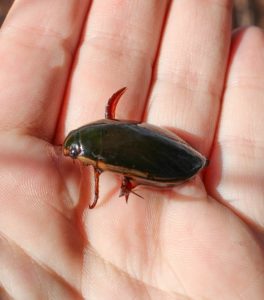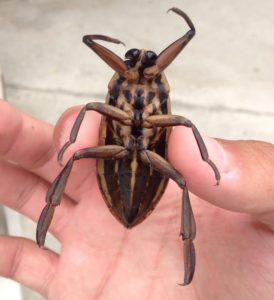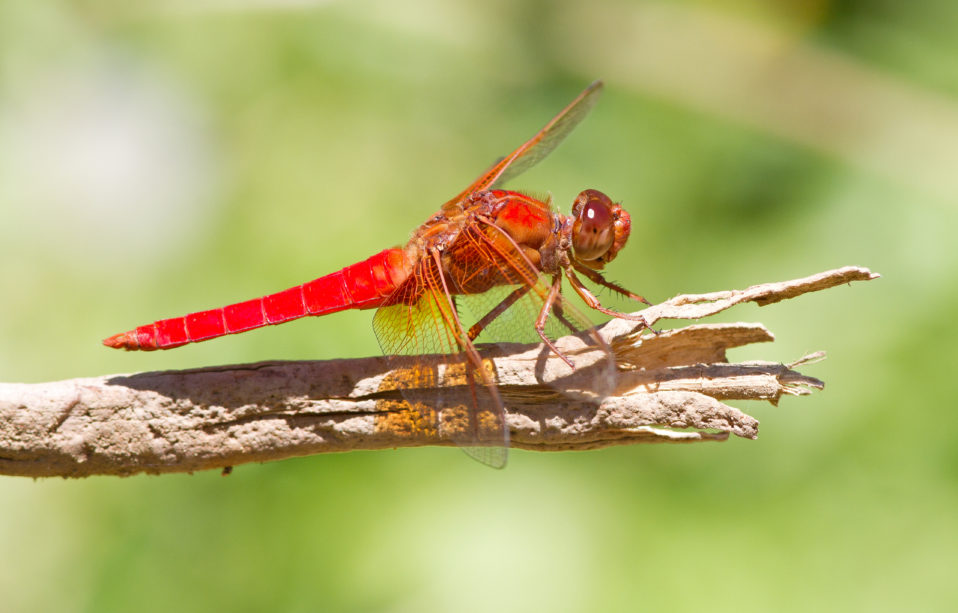Wildlife Wednesday: Denizens of the Pond
One of the park improvements that was put in this past Spring is the new larger Cypress Pond, at the South end of the park, near the playground. This larger pond, along with the new deck, gives us all kinds of opportunities to teach kids about aquatic ecosystems through dip-netting and observation. The larger size, with a greater variety of native aquatic plants, is bound to attract all manner of aquatic creatures, many which have not been seen in the park before. Today, we’ll have a look at some of the aquatic and semi-aquatic insects that we have already encountered in our new pond.
 The Neon Skimmer (Libellula croceipennis) is an unmistakable dragonfly. The bright red males (above photo) are often seen sunning on perches or patrolling the shoreline, looking for prey, chasing away rivals, or looking for females. The females (left) are less colorful, but are gorgeous as well, with a golden brown coloration and a cream colored stripe down the back. Both are large active dragonflies, found near water, though the females are often found in fields away from water as well, being less territorial than the males. Neon Skimmers feed on other flying insects of various kinds. The females can often be seen leading males around in a complicated fast paced courtship ritual dance/chase, at the edges of ponds and streams. As with all dragonflies, they lay their eggs in the water, and the young, called nymphs, are aquatic, and emerge as adults months later.
The Neon Skimmer (Libellula croceipennis) is an unmistakable dragonfly. The bright red males (above photo) are often seen sunning on perches or patrolling the shoreline, looking for prey, chasing away rivals, or looking for females. The females (left) are less colorful, but are gorgeous as well, with a golden brown coloration and a cream colored stripe down the back. Both are large active dragonflies, found near water, though the females are often found in fields away from water as well, being less territorial than the males. Neon Skimmers feed on other flying insects of various kinds. The females can often be seen leading males around in a complicated fast paced courtship ritual dance/chase, at the edges of ponds and streams. As with all dragonflies, they lay their eggs in the water, and the young, called nymphs, are aquatic, and emerge as adults months later.
The Giant Predaceous Diving Beetle (Cybister fimbreolatus) is rather large, for an aquatic beetle at least, growing up to 3 1/2 cm in length. With large hind legs, modified for swimming, they can be seen traveling up and down in the water column, searching for prey. These large shiny dark green beetles may feed on other aquatic insects, tadpoles, and even small fish, like minnows. This is just one of a few species of diving beetles found in the pond, some of them jet black, and some of them brightly colored with golden sunburst patterns on a dark background. Though they are mainly aquatic, they may sometimes be found flying from one location to another, away from water.
 Sometimes called “Toe-biters”, Giant Waterbugs (Lethocerus americanus) grow up to 6 cm in length. As their names suggest, they may deliver a nasty and painful bite with their large proboscis. They usually use this tube-like mouth part to inject venom into prey (usually other aquatic insects, tadpoles, and small fish). They then suck out the liquifying insides! As with the diving beetles, there are actually several species of large water bugs in the pond, all of which are excellent swimmers, but can fly from one body of water to another. They’re all very well camouflaged, being various shades of brown and green.
Sometimes called “Toe-biters”, Giant Waterbugs (Lethocerus americanus) grow up to 6 cm in length. As their names suggest, they may deliver a nasty and painful bite with their large proboscis. They usually use this tube-like mouth part to inject venom into prey (usually other aquatic insects, tadpoles, and small fish). They then suck out the liquifying insides! As with the diving beetles, there are actually several species of large water bugs in the pond, all of which are excellent swimmers, but can fly from one body of water to another. They’re all very well camouflaged, being various shades of brown and green.
The next time you’re out in the park on a walk, stop by the Cypress Pond, next to the South End playground, and see if you can find any of these insects (or some we haven’t yet seen ourselves).
Thanks for joining us, and see you soon!
Eric Duran, Staff Naturalist
Photographs: Male Skimmer by Steve Berardi | Wikimedia; Female Skimmer by Bill Carrell | INaturalist; Diving Beetle by Monikah Schuschu | Flickr; Water Bug by David Hoover | Flickr



